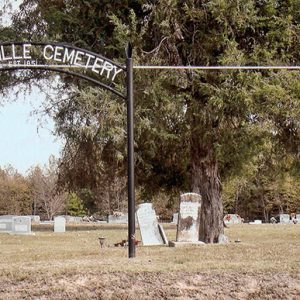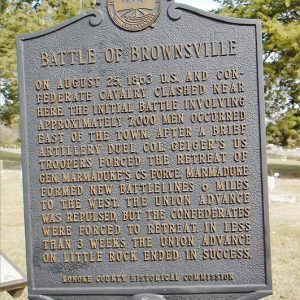calsfoundation@cals.org
Brownsville (Lonoke County)
Brownsville served as the county seat of Prairie County for approximately twenty-two years. Located on the Memphis to Little Rock Road, commonly known as the Military Road, it became an important trade center and was the site of a Civil War skirmish in 1863.
Many settlers lived in the area by the early 1820s, but when the federal government authorized the construction of the road connecting Memphis, Tennessee, to Little Rock (Pulaski County) in 1824, more settlers were attracted to the area. Early area settler and local contractor Samson Gray was given the contract to construct the road from the White River to the north shore of the Arkansas River. The road was a major avenue of trade being used for commerce, mail delivery, and stagecoach service. In the 1830s, it was used as one of the routes for the removal of the Choctaw, Creek, Cherokee, and Chickasaw Indians.
On November 24, 1846, Prairie County was created, and the settlement of Brownsville was founded almost immediately. On August 9, 1849, the Arkansas Gazette announced that any “persons wishing to make an investment in town property in a thriving and flourishing county will do well to attend this sale” of lots in the town of Brownsville. The town was named in honor of Major Jacob Brown of Little Rock, one of the first of the United States’ casualties in the Mexican War.
The town grew slowly, with a wood-frame courthouse for government business and a brick jail being constructed. On December 5, 1856, the town was incorporated and, by 1860, was said to have more than 2,000 citizens and several businesses, a hotel, churches, a school, and a Masonic and International Order of Odd Fellows lodge. In 1858, I. C. Hicks and Co. founded the town’s first newspaper, The Echo. In 1860, it was sold and renamed the Prairie Democrat. It was sold again in 1861 and renamed the Brownsville Banner.
Most town citizens were supporters of the Confederacy during the Civil War. When the 1861 secession of Virginia was reported, the courthouse was illuminated with some 300 candles in recognition of the state’s action. About $10,000 was appropriated to put the county “upon a war footing.” Many of the town’s men enlisted in Confederate companies. Both Union and Confederate units foraged through the area, taking food and livestock and sometimes damaging private and public property. On August 25, 1863, the Skirmish at Brownsville was fought, involving some 7,000 combined Union and Confederate forces. After a brief artillery duel, Confederate forces fell back and then repulsed a Union attack before retreating down the Military Road. The skirmish was the first of a series of actions that led to the fall of Little Rock in September. In 1864, there were more skirmishes at Brownsville, on July 13–14 and July 30.
Brownsville never recovered from the devastation of the war. In 1867, a survey was made for the completion of the Memphis and Little Rock Railroad, and when the tracks were laid, about three miles south of the town, citizens began relocating there. The town’s future was further threatened when it was decided in 1868 to relocate the county seat to DeValls Bluff on the White River. The last session of the county court held in Brownsville took place in April 1868. The final blow came in April 1873 with the creation of Lonoke County and the designation of Lonoke, approximately three miles to the south, as the county seat. Now a part of Lonoke County, Brownsville had completely lost its importance.
Today, Brownsville is a small community located on State Highway 31. What was once the old town is now farmland, and all that remains above ground is the cemetery. A marker placed during the Arkansas Centennial celebration indicates where the courthouse once stood, and two Civil War markers recount the 1863 skirmish. In 2003, the segment of the Memphis to Little Rock Road that passed through Brownsville was placed on the National Register of Historic Places.
For additional information:
Biographical and Historical Memoirs of Central Arkansas. Chicago: Goodspeed Publishing Co., 1889.
Biographical and Historical Memoirs of Eastern Arkansas. Chicago: Goodspeed Publishing Co., 1890.
Lawson, Harriet E. “Brownsville—Scene of Skirmish on August 25, 1863.” Newsletter of the Lonoke County Historical Society 2 (Spring 1983): 7.
McGraw, Shirley, and Carol Bevis. Lonoke County, Arkansas: A Pictorial History. Virginia Beach, VA: The Donning Company, 1998.
Portis, Mary Gray. “A Ghost Town of Arkansas.” Newsletter of the Lonoke County Historical Society 3 (Winter 1984): 4.
Mike Polston
CALS Encyclopedia of Arkansas
 Brownsville Baptist Church
Brownsville Baptist Church  Brownsville Cemetery
Brownsville Cemetery  Brownsville Skirmish
Brownsville Skirmish  Lonoke County Map
Lonoke County Map  Lonoke County Seat Memorial
Lonoke County Seat Memorial 



Comments
No comments on this entry yet.